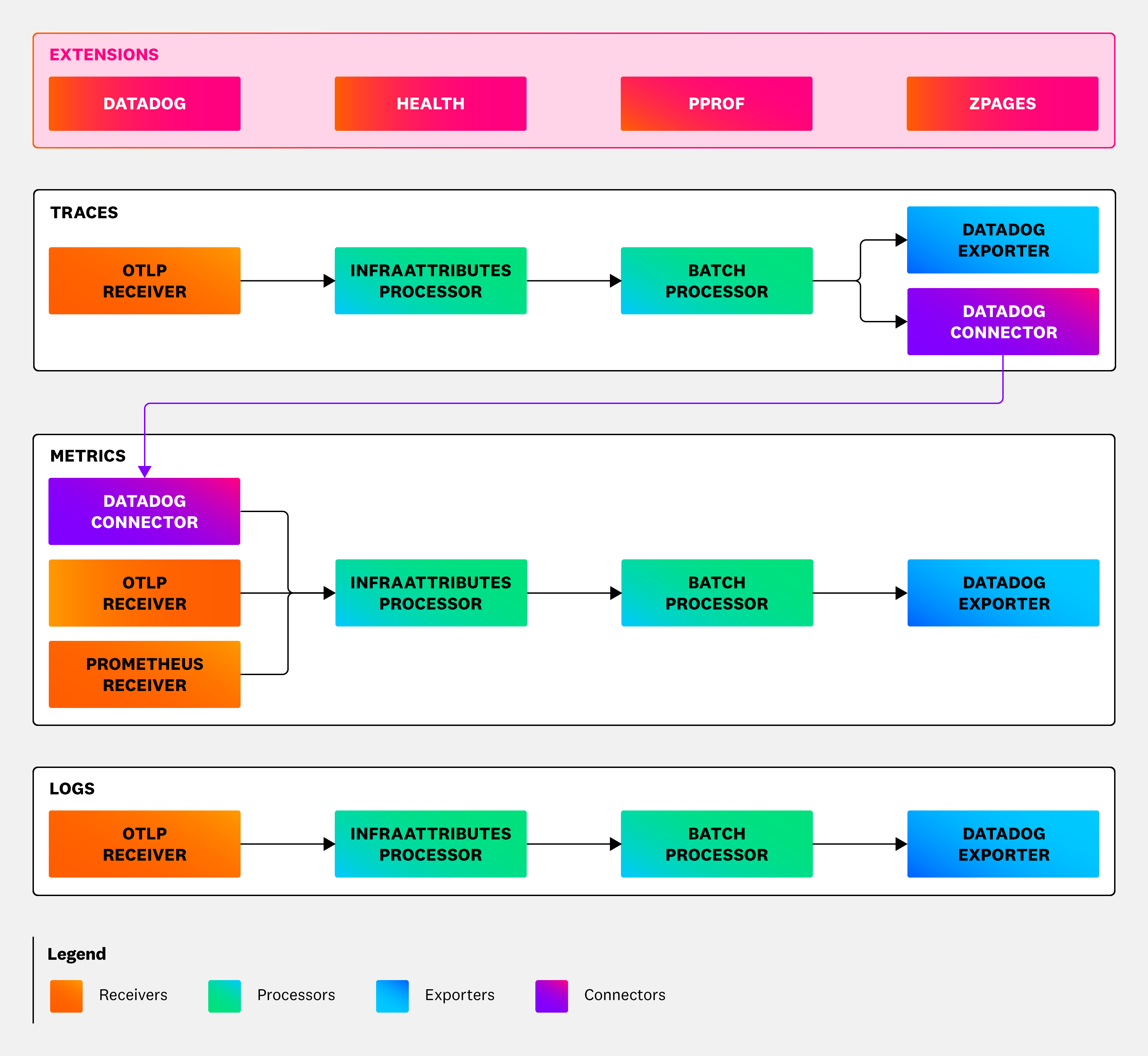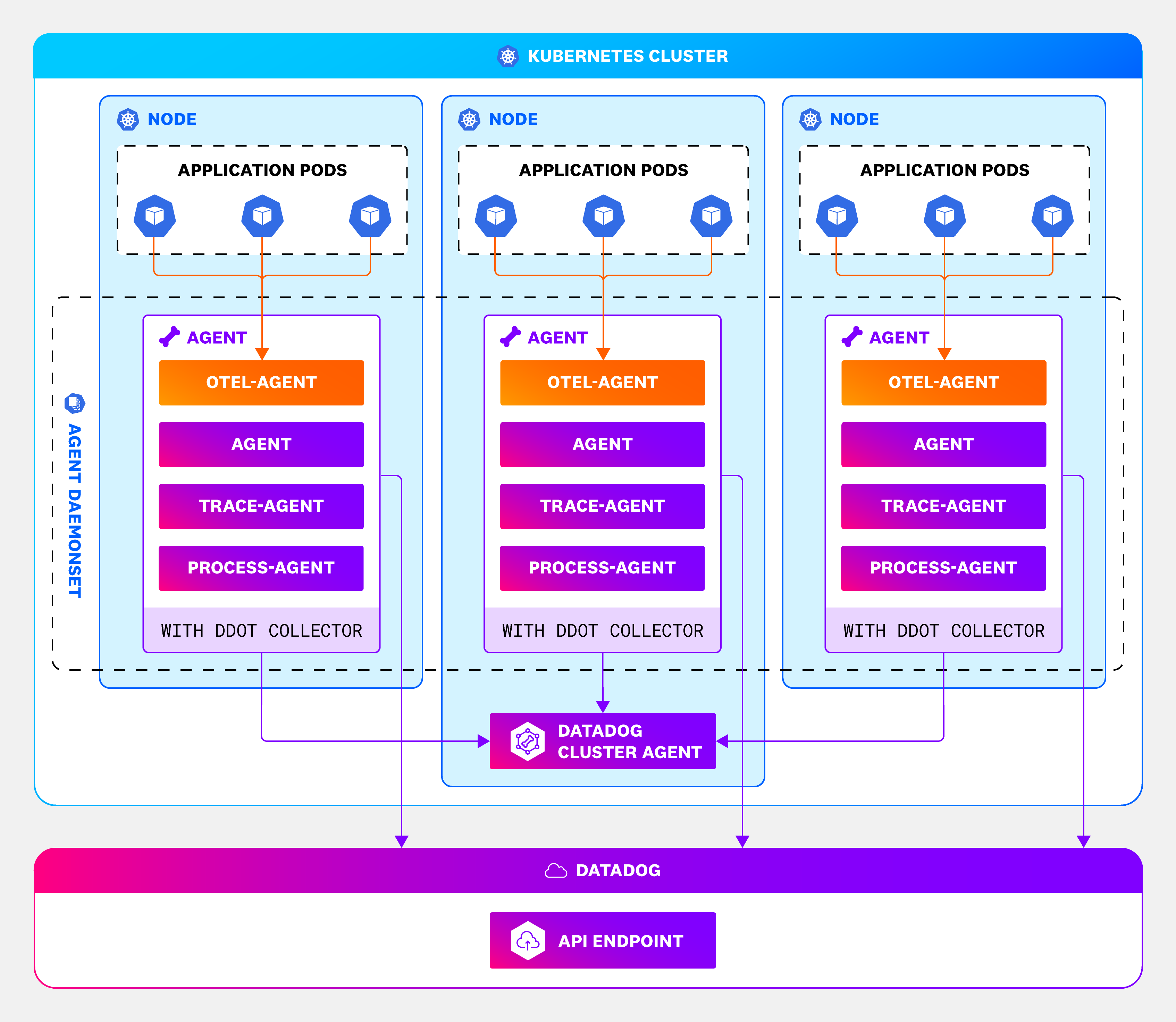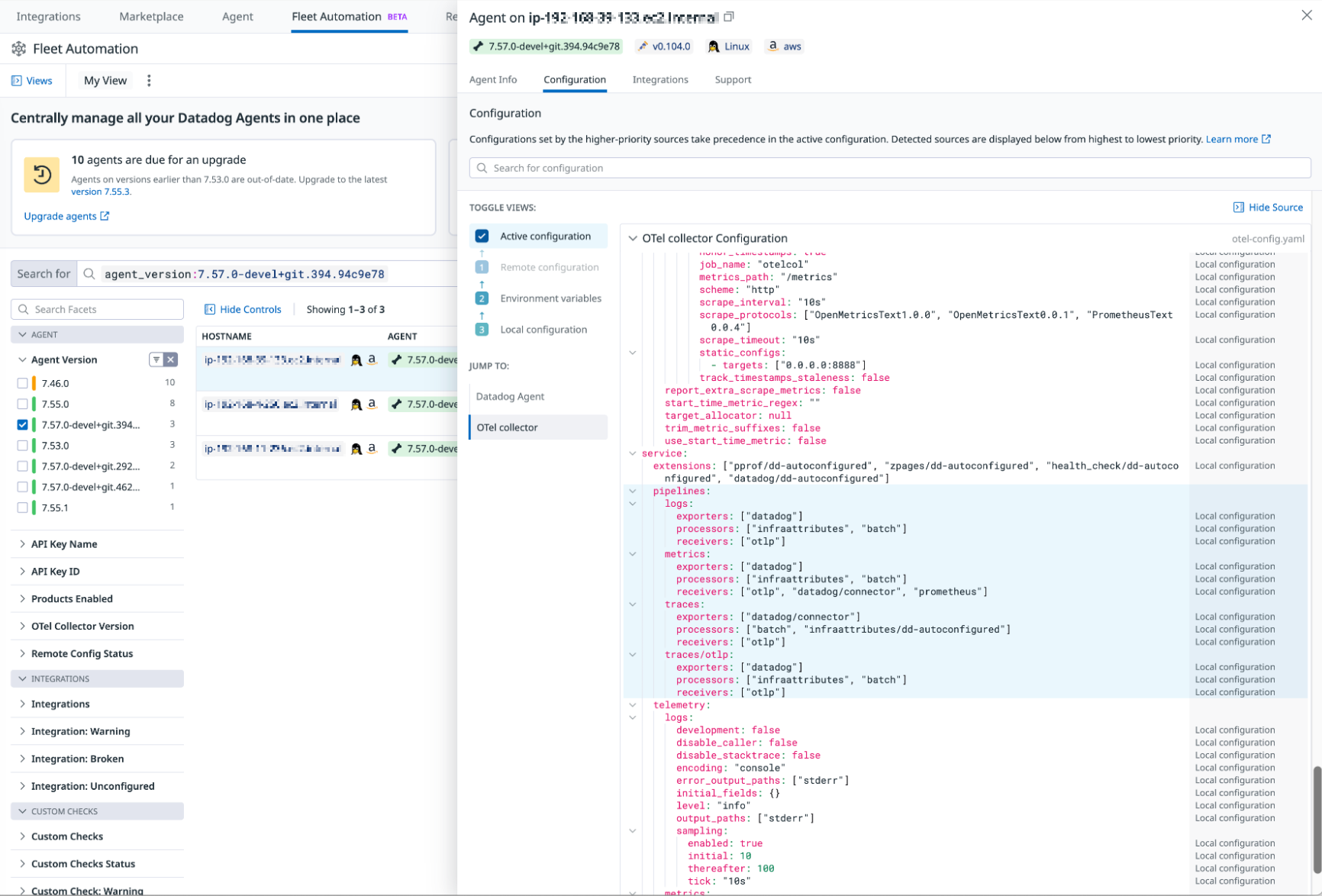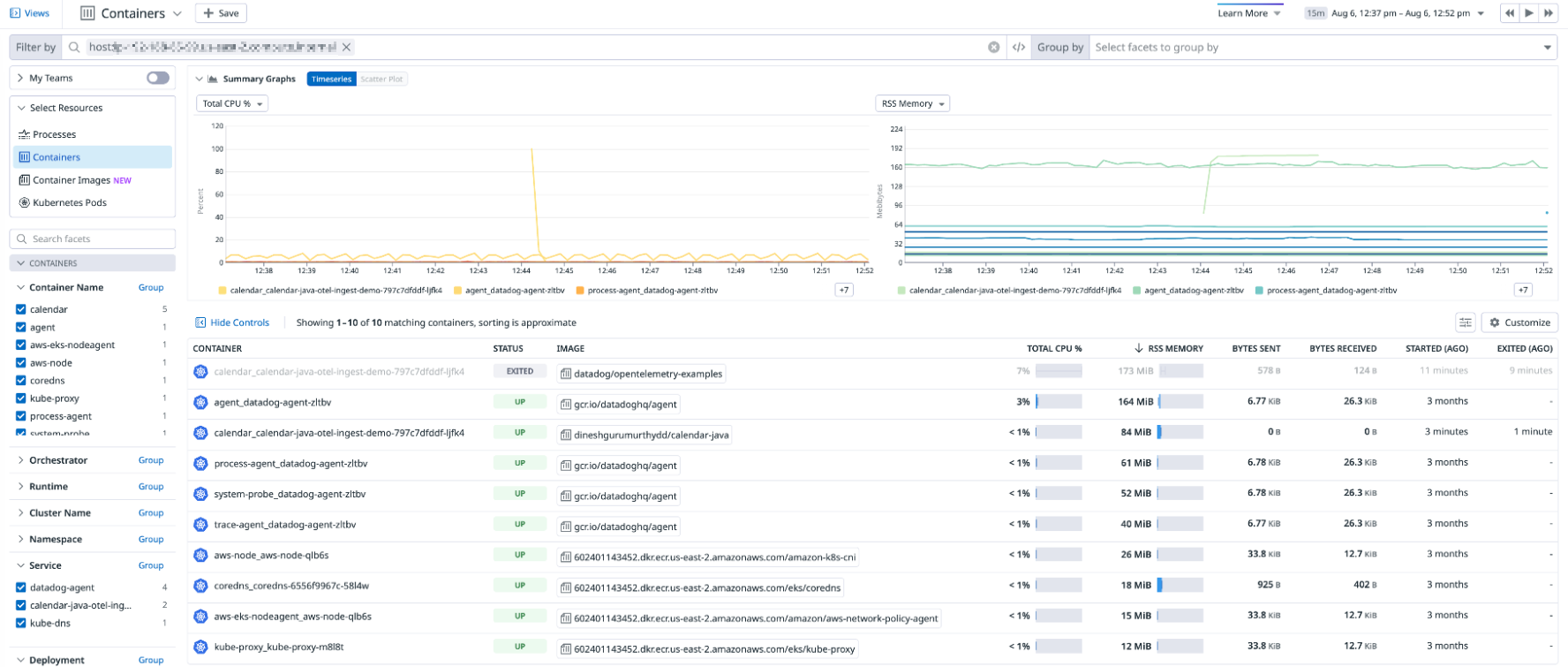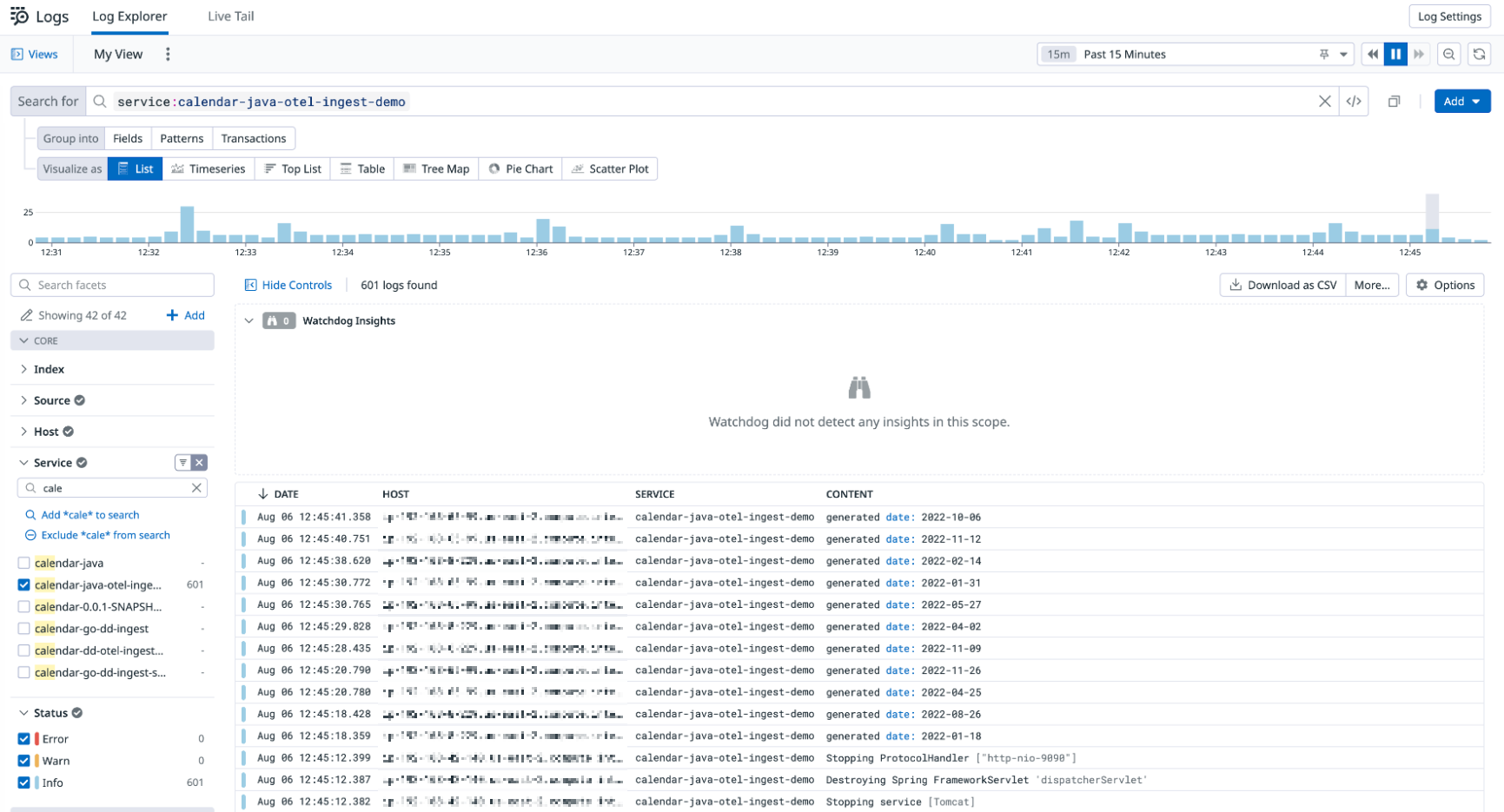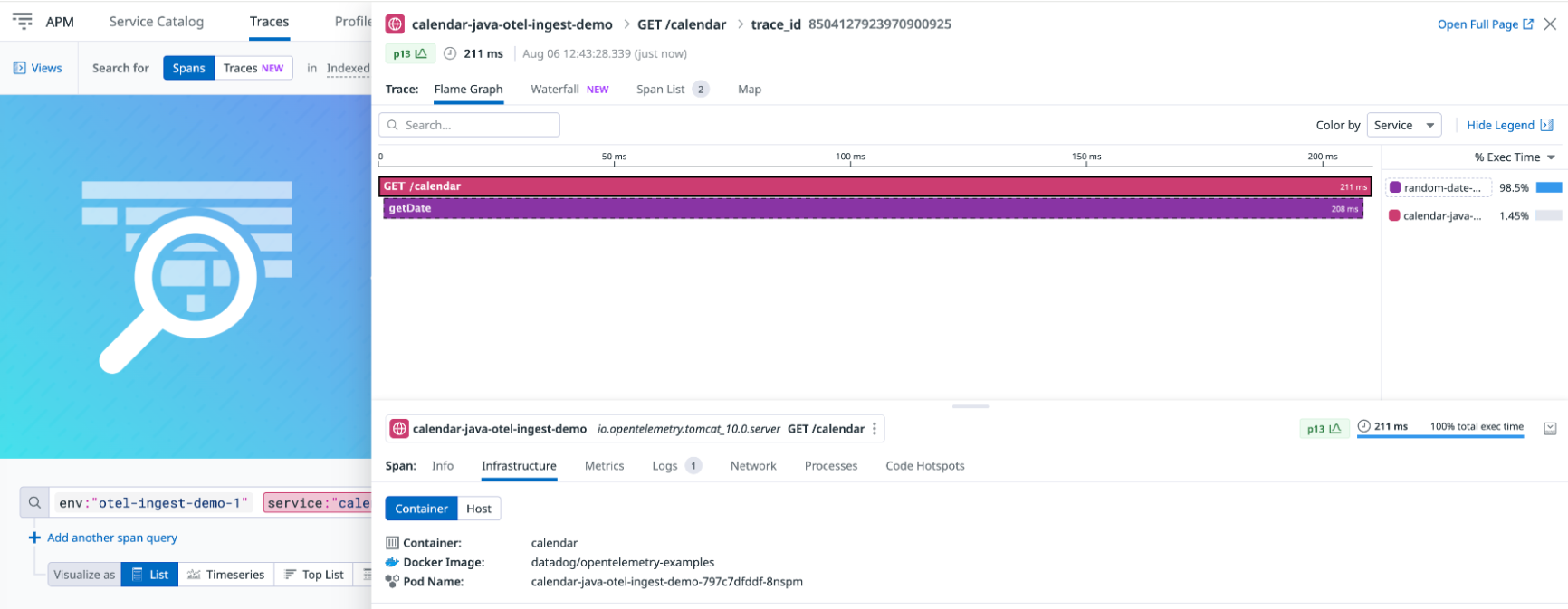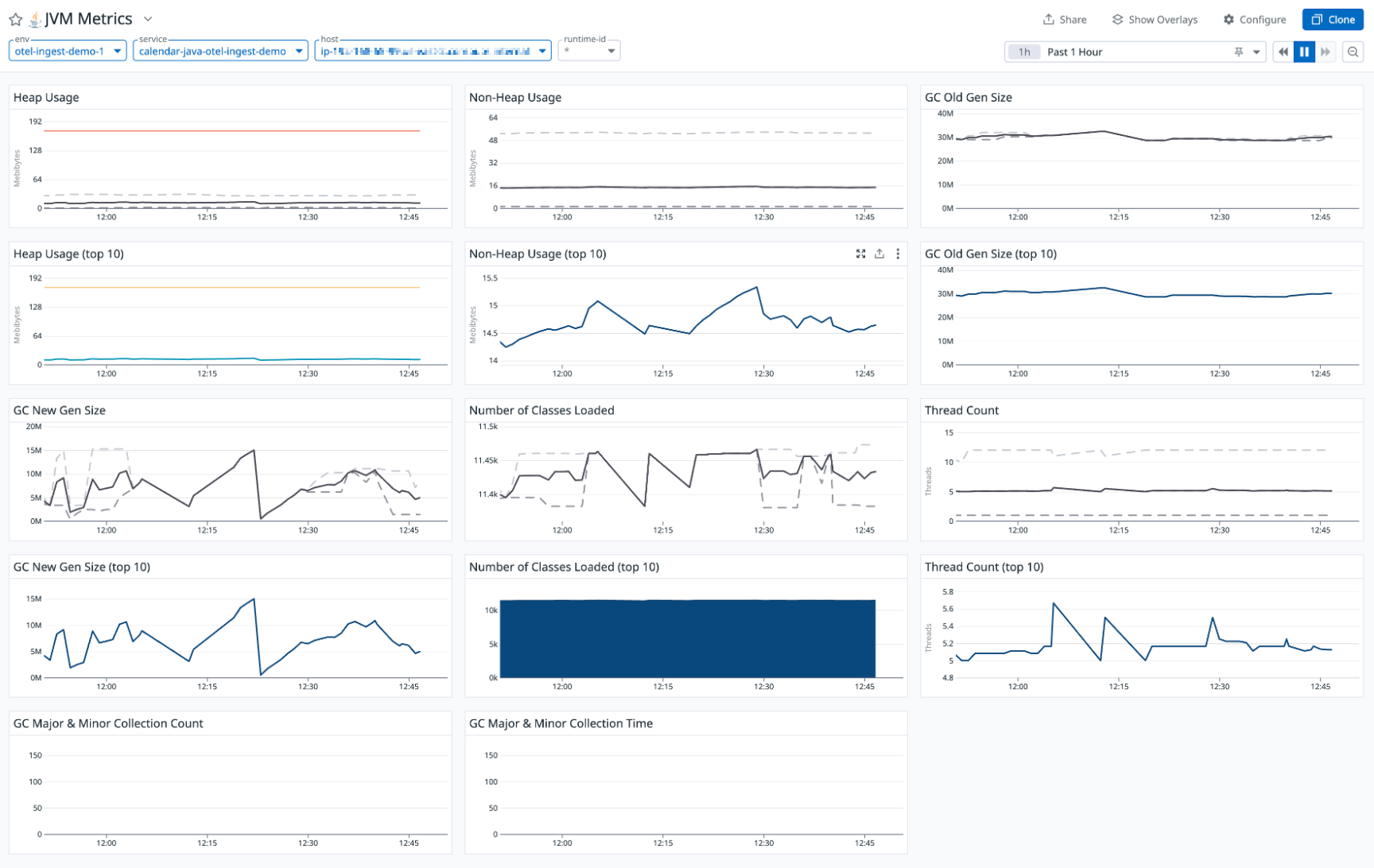- Essentials
- Getting Started
- Agent
- API
- APM Tracing
- Containers
- Dashboards
- Database Monitoring
- Datadog
- Datadog Site
- DevSecOps
- Incident Management
- Integrations
- Internal Developer Portal
- Logs
- Monitors
- Notebooks
- OpenTelemetry
- Profiler
- Search
- Session Replay
- Security
- Serverless for AWS Lambda
- Software Delivery
- Synthetic Monitoring and Testing
- Tags
- Workflow Automation
- Learning Center
- Support
- Glossary
- Standard Attributes
- Guides
- Agent
- Integrations
- Developers
- Authorization
- DogStatsD
- Custom Checks
- Integrations
- Build an Integration with Datadog
- Create an Agent-based Integration
- Create an API-based Integration
- Create a Log Pipeline
- Integration Assets Reference
- Build a Marketplace Offering
- Create an Integration Dashboard
- Create a Monitor Template
- Create a Cloud SIEM Detection Rule
- Install Agent Integration Developer Tool
- Service Checks
- IDE Plugins
- Community
- Guides
- OpenTelemetry
- Administrator's Guide
- API
- Partners
- Datadog Mobile App
- DDSQL Reference
- CoScreen
- CoTerm
- Remote Configuration
- Cloudcraft (Standalone)
- In The App
- Dashboards
- Notebooks
- DDSQL Editor
- Reference Tables
- Sheets
- Monitors and Alerting
- Watchdog
- Metrics
- Bits AI
- Internal Developer Portal
- Error Tracking
- Change Tracking
- Service Management
- Service Level Objectives
- Incident Management
- On-Call
- Status Pages
- Event Management
- Case Management
- Actions & Remediations
- Infrastructure
- Cloudcraft
- Resource Catalog
- Universal Service Monitoring
- Hosts
- Containers
- Processes
- Serverless
- Network Monitoring
- Storage Management
- Cloud Cost
- Application Performance
- APM
- APM Terms and Concepts
- Application Instrumentation
- APM Metrics Collection
- Trace Pipeline Configuration
- Correlate Traces with Other Telemetry
- Trace Explorer
- Recommendations
- Code Origin for Spans
- Service Observability
- Endpoint Observability
- Dynamic Instrumentation
- Live Debugger
- Error Tracking
- Data Security
- Guides
- Troubleshooting
- Continuous Profiler
- Database Monitoring
- Agent Integration Overhead
- Setup Architectures
- Setting Up Postgres
- Setting Up MySQL
- Setting Up SQL Server
- Setting Up Oracle
- Setting Up Amazon DocumentDB
- Setting Up MongoDB
- Connecting DBM and Traces
- Data Collected
- Exploring Database Hosts
- Exploring Query Metrics
- Exploring Query Samples
- Exploring Database Schemas
- Exploring Recommendations
- Troubleshooting
- Guides
- Data Streams Monitoring
- Data Jobs Monitoring
- Data Observability
- Digital Experience
- Real User Monitoring
- Synthetic Testing and Monitoring
- Continuous Testing
- Product Analytics
- Software Delivery
- CI Visibility
- CD Visibility
- Deployment Gates
- Test Optimization
- Code Coverage
- PR Gates
- DORA Metrics
- Feature Flags
- Security
- Security Overview
- Cloud SIEM
- Code Security
- Cloud Security
- App and API Protection
- Workload Protection
- Sensitive Data Scanner
- AI Observability
- Log Management
- Administration
Install the DDOT Collector as a Kubernetes DaemonSet
This product is not supported for your selected Datadog site. ().
Overview
Follow this guide to deploy the Datadog Distribution of OpenTelemetry (DDOT) Collector as a Kubernetes DaemonSet using Helm or the Datadog Operator.
Need additional OpenTelemetry components? If you need components beyond those included in the default package, follow Use Custom OpenTelemetry Components to extend the Datadog Agent's capabilities. For a list of components included by default, see OpenTelemetry Collector components.
Requirements
To complete this guide, you need the following:
Datadog account:
- Create a Datadog account if you don’t have one.
- Find or create your Datadog API key.
Software: Install and set up the following on your machine:
- A Kubernetes cluster (v1.29+)
- Note: EKS Fargate and GKE Autopilot environments are not supported
- Helm (v3+)
- kubectl
Join the Preview!
Support for deploying the DDOT Collector on Linux-based bare-metal hosts and virtual machines is in Preview. To get started, follow the Linux documentation.
Install the Datadog Agent with OpenTelemetry Collector
Select installation method
Choose one of the following installation methods:
- Datadog Operator: A Kubernetes-native approach that automatically reconciles and maintains your Datadog setup. It reports deployment status, health, and errors in its Custom Resource status, and it limits the risk of misconfiguration thanks to higher-level configuration options.
- Helm chart: A straightforward way to deploy Datadog Agent. It provides versioning, rollback, and templating capabilities, making deployments consistent and easier to replicate.
Install the Datadog Operator
You can install the Datadog Operator in your cluster using the Datadog Operator Helm chart:
helm repo add datadog https://helm.datadoghq.com
helm repo update
helm install datadog-operator datadog/datadog-operator
Add the Datadog Helm Repository
To add the Datadog repository to your Helm repositories:
helm repo add datadog https://helm.datadoghq.com
helm repo update
Set up Datadog API key
- Get the Datadog API key.
- Store the API key as a Kubernetes secret:Replace
kubectl create secret generic datadog-secret \ --from-literal api-key=<DD_API_KEY><DD_API_KEY>with your actual Datadog API key.
Configure the Datadog Agent
After deploying the Datadog Operator, create the DatadogAgent resource that triggers the deployment of the Datadog Agent, Cluster Agent and Cluster Checks Runners (if used) in your Kubernetes cluster. The Datadog Agent deploys as a DaemonSet, running a pod on every node of your cluster.
- Use the
datadog-agent.yamlfile to specify yourDatadogAgentdeployment configuration.
datadog-agent.yaml
apiVersion: datadoghq.com/v2alpha1
kind: DatadogAgent
metadata:
name: datadog
spec:
global:
clusterName: <CLUSTER_NAME>
site: <DATADOG_SITE>
credentials:
apiSecret:
secretName: datadog-secret
keyName: api-key- Replace
<CLUSTER_NAME>with a name for your cluster. - Replace
<DATADOG_SITE>with your Datadog site. Your site is. (Ensure the correct DATADOG SITE is selected on the right.)
- Enable the OpenTelemetry Collector:
datadog-agent.yaml
# Enable Features
features:
otelCollector:
enabled: trueThe Datadog Operator automatically binds the OpenTelemetry Collector to ports 4317 (named otel-grpc) and 4318 (named otel-http) by default.
- (Optional) Enable additional Datadog features:
Enabling these features may incur additional charges. Review the pricing page and talk to your Customer Success Manager before proceeding.
datadog-agent.yaml
# Enable Features
features:
...
apm:
enabled: true
orchestratorExplorer:
enabled: true
processDiscovery:
enabled: true
liveProcessCollection:
enabled: true
usm:
enabled: true
clusterChecks:
enabled: trueWhen enabling additional Datadog features, always use the Datadog or OpenTelemetry Collector configuration files instead of relying on Datadog environment variables.
Use a YAML file to specify the Helm chart parameters for the Datadog Agent chart.
- Create an empty
datadog-values.yamlfile:
touch datadog-values.yaml
Unspecified parameters use defaults from values.yaml.
- Configure the Datadog API key secret:
datadog-values.yaml
datadog:
site: <DATADOG_SITE>
apiKeyExistingSecret: datadog-secretSet <DATADOG_SITE> to your Datadog site. Otherwise, it defaults to datadoghq.com, the US1 site.
- Enable the OpenTelemetry Collector and configure the essential ports:
datadog-values.yaml
datadog:
...
otelCollector:
enabled: true
ports:
- containerPort: "4317" # default port for OpenTelemetry gRPC receiver.
hostPort: "4317"
name: otel-grpc
- containerPort: "4318" # default port for OpenTelemetry HTTP receiver
hostPort: "4318"
name: otel-httpSet the hostPort to expose the container port to the external network. This enables configuring the OTLP exporter to point to the IP address of the node where the Datadog Agent is assigned.
If you don’t want to expose the port, you can use the Agent service instead:
- Remove the
hostPortentries from yourdatadog-values.yamlfile. - In your application’s deployment file (
deployment.yaml), configure the OTLP exporter to use the Agent service:env: - name: OTEL_EXPORTER_OTLP_ENDPOINT value: 'http://<SERVICE_NAME>.<SERVICE_NAMESPACE>.svc.cluster.local' - name: OTEL_EXPORTER_OTLP_PROTOCOL value: 'grpc'
- (Optional) Enable additional Datadog features:
Enabling these features may incur additional charges. Review the pricing page and talk to your Customer Success Manager before proceeding.
datadog-values.yaml
datadog:
...
apm:
portEnabled: true
peer_service_aggregation: true
orchestratorExplorer:
enabled: true
processAgent:
enabled: true
processCollection: trueWhen enabling additional Datadog features, always use the Datadog or OpenTelemetry Collector configuration files instead of relying on Datadog environment variables.
- (Optional) Collect pod labels and use them as tags to attach to metrics, traces, and logs:
Custom metrics may impact billing. See the custom metrics billing page for more information.
datadog-values.yaml
datadog:
...
podLabelsAsTags:
app: kube_app
release: helm_releaseCompleted datadog-values.yaml file
Completed datadog-values.yaml file
Your datadog-values.yaml file should look something like this:
datadog-values.yaml
datadog:
site: datadoghq.com
apiKeyExistingSecret: datadog-secret
otelCollector:
enabled: true
ports:
- containerPort: "4317"
hostPort: "4317"
name: otel-grpc
- containerPort: "4318"
hostPort: "4318"
name: otel-http
apm:
portEnabled: true
peer_service_aggregation: true
orchestratorExplorer:
enabled: true
processAgent:
enabled: true
processCollection: true
podLabelsAsTags:
app: kube_app
release: helm_release
Configure the OpenTelemetry Collector
The Datadog Operator provides a sample OpenTelemetry Collector configuration that you can use as a starting point. If you need to modify this configuration, the Datadog Operator supports two ways of providing a custom Collector configuration:
- Inline configuration: Add your custom Collector configuration directly in the
features.otelCollector.conf.configDatafield. - ConfigMap-based configuration: Store your Collector configuration in a ConfigMap and reference it in the
features.otelCollector.conf.configMapfield. This approach allows you to keep Collector configuration decoupled from theDatadogAgentresource.
Inline Collector configuration
In the snippet below, the Collector configuration is placed directly under the features.otelCollector.conf.configData parameter:
datadog-agent.yaml
...
# Enable Features
features:
otelCollector:
enabled: true
ports:
- containerPort: 4317
hostPort: 4317
name: otel-grpc
- containerPort: 4318
hostPort: 4318
name: otel-http
conf:
configData: |-
receivers:
prometheus:
config:
scrape_configs:
- job_name: "otelcol"
scrape_interval: 10s
static_configs:
- targets:
- 0.0.0.0:8888
otlp:
protocols:
grpc:
endpoint: 0.0.0.0:4317
http:
endpoint: 0.0.0.0:4318
exporters:
debug:
verbosity: detailed
datadog:
api:
key: ${env:DD_API_KEY}
site: ${env:DD_SITE}
processors:
infraattributes:
cardinality: 2
batch:
timeout: 10s
connectors:
datadog/connector:
traces:
service:
pipelines:
traces:
receivers: [otlp]
processors: [infraattributes, batch]
exporters: [debug, datadog, datadog/connector]
metrics:
receivers: [otlp, datadog/connector, prometheus]
processors: [infraattributes, batch]
exporters: [debug, datadog]
logs:
receivers: [otlp]
processors: [infraattributes, batch]
exporters: [debug, datadog]For the infraattributes processor to add Kubernetes tags, your telemetry must include the container.id resource attribute. This is often, but not always, added by OTel SDK auto-instrumentation.
If your tags are missing, see the troubleshooting guide for details on how to add this attribute.
When you apply the datadog-agent.yaml file containing this DatadogAgent resource, the Operator automatically mounts the Collector configuration into the Agent DaemonSet.
Completed datadog-agent.yaml file with inlined Collector config
Completed datadog-agent.yaml file with inlined Collector config
Completed datadog-agent.yaml with inline Collector configuration should look something like this:
datadog-agent.yaml
apiVersion: datadoghq.com/v2alpha1
kind: DatadogAgent
metadata:
name: datadog
spec:
global:
clusterName: <CLUSTER_NAME>
site: <DATADOG_SITE>
credentials:
apiSecret:
secretName: datadog-secret
keyName: api-key
# Enable Features
features:
apm:
enabled: true
orchestratorExplorer:
enabled: true
processDiscovery:
enabled: true
liveProcessCollection:
enabled: true
usm:
enabled: true
clusterChecks:
enabled: true
otelCollector:
enabled: true
ports:
- containerPort: 4317
hostPort: 4317
name: otel-grpc
- containerPort: 4318
hostPort: 4318
name: otel-http
conf:
configData: |-
receivers:
prometheus:
config:
scrape_configs:
- job_name: "datadog-agent"
scrape_interval: 10s
static_configs:
- targets:
- 0.0.0.0:8888
otlp:
protocols:
grpc:
endpoint: 0.0.0.0:4317
http:
endpoint: 0.0.0.0:4318
exporters:
debug:
verbosity: detailed
datadog:
api:
key: ${env:DD_API_KEY}
site: ${env:DD_SITE}
processors:
infraattributes:
cardinality: 2
batch:
timeout: 10s
connectors:
datadog/connector:
traces:
service:
pipelines:
traces:
receivers: [otlp]
processors: [infraattributes, batch]
exporters: [debug, datadog, datadog/connector]
metrics:
receivers: [otlp, datadog/connector, prometheus]
processors: [infraattributes, batch]
exporters: [debug, datadog]
logs:
receivers: [otlp]
processors: [infraattributes, batch]
exporters: [debug, datadog]ConfigMap-based Collector Configuration
For more complex or frequently updated configurations, storing Collector configuration in a ConfigMap can simplify version control.
- Create a ConfigMap that contains your Collector configuration:
configmap.yaml
apiVersion: v1
kind: ConfigMap
metadata:
name: otel-agent-config-map
namespace: system
data:
# must be named otel-config.yaml
otel-config.yaml: |-
receivers:
prometheus:
config:
scrape_configs:
- job_name: "datadog-agent"
scrape_interval: 10s
static_configs:
- targets:
- 0.0.0.0:8888
otlp:
protocols:
grpc:
endpoint: 0.0.0.0:4317
http:
endpoint: 0.0.0.0:4318
exporters:
debug:
verbosity: detailed
datadog:
api:
key: ${env:DD_API_KEY}
site: ${env:DD_SITE}
processors:
infraattributes:
cardinality: 2
batch:
timeout: 10s
connectors:
datadog/connector:
traces:
service:
pipelines:
traces:
receivers: [otlp]
processors: [infraattributes, batch]
exporters: [debug, datadog, datadog/connector]
metrics:
receivers: [otlp, datadog/connector, prometheus]
processors: [infraattributes, batch]
exporters: [debug, datadog]
logs:
receivers: [otlp]
processors: [infraattributes, batch]
exporters: [debug, datadog]The field for Collector config in the ConfigMap must be called
otel-config.yaml.- Reference the
otel-agent-config-mapConfigMap in yourDatadogAgentresource usingfeatures.otelCollector.conf.configMapparameter:
datadog-agent.yaml
...
# Enable Features
features:
otelCollector:
enabled: true
ports:
- containerPort: 4317
hostPort: 4317
name: otel-grpc
- containerPort: 4318
hostPort: 4318
name: otel-http
conf:
configMap:
name: otel-agent-config-mapThe Operator automatically mounts otel-config.yaml from the ConfigMap into the Agent’s OpenTelemetry Collector DaemonSet.
Completed datadog-agent.yaml file with Collector config in the ConfigMap
Completed datadog-agent.yaml file with Collector config in the ConfigMap
Completed datadog-agent.yaml with Collector configuration defined as ConfigMap should look something like this:
datadog-agent.yaml
apiVersion: datadoghq.com/v2alpha1
kind: DatadogAgent
metadata:
name: datadog
spec:
global:
clusterName: <CLUSTER_NAME>
site: <DATADOG_SITE>
credentials:
apiSecret:
secretName: datadog-secret
keyName: api-key
# Enable Features
features:
apm:
enabled: true
orchestratorExplorer:
enabled: true
processDiscovery:
enabled: true
liveProcessCollection:
enabled: true
usm:
enabled: true
clusterChecks:
enabled: true
otelCollector:
enabled: true
ports:
- containerPort: 4317
hostPort: 4317
name: otel-grpc
- containerPort: 4318
hostPort: 4318
name: otel-http
conf:
configMap:
name: otel-agent-config-map
---
apiVersion: v1
kind: ConfigMap
metadata:
name: otel-agent-config-map
namespace: system
data:
# must be named otel-config.yaml
otel-config.yaml: |-
receivers:
prometheus:
config:
scrape_configs:
- job_name: "datadog-agent"
scrape_interval: 10s
static_configs:
- targets:
- 0.0.0.0:8888
otlp:
protocols:
grpc:
endpoint: 0.0.0.0:4317
http:
endpoint: 0.0.0.0:4318
exporters:
debug:
verbosity: detailed
datadog:
api:
key: ${env:DD_API_KEY}
site: ${env:DD_SITE}
processors:
infraattributes:
cardinality: 2
batch:
timeout: 10s
connectors:
datadog/connector:
traces:
service:
pipelines:
traces:
receivers: [otlp]
processors: [infraattributes, batch]
exporters: [debug, datadog, datadog/connector]
metrics:
receivers: [otlp, datadog/connector, prometheus]
processors: [infraattributes, batch]
exporters: [debug, datadog]
logs:
receivers: [otlp]
processors: [infraattributes, batch]
exporters: [debug, datadog]The Datadog Helm chart provides a sample OpenTelemetry Collector configuration that you can use as a starting point. This section walks you through the predefined pipelines and included OpenTelemetry components.
This is the full OpenTelemetry Collector configuration in otel-config.yaml:
otel-config.yaml
receivers:
prometheus:
config:
scrape_configs:
- job_name: "otelcol"
scrape_interval: 10s
static_configs:
- targets: ["0.0.0.0:8888"]
otlp:
protocols:
grpc:
endpoint: 0.0.0.0:4317
http:
endpoint: 0.0.0.0:4318
exporters:
debug:
verbosity: detailed
datadog:
api:
key: ${env:DD_API_KEY}
site: ${env:DD_SITE}
processors:
infraattributes:
cardinality: 2
batch:
timeout: 10s
connectors:
datadog/connector:
traces:
service:
pipelines:
traces:
receivers: [otlp]
processors: [infraattributes, batch]
exporters: [datadog, datadog/connector]
metrics:
receivers: [otlp, datadog/connector, prometheus]
processors: [infraattributes, batch]
exporters: [datadog]
logs:
receivers: [otlp]
processors: [infraattributes, batch]
exporters: [datadog]For the infraattributes processor to add Kubernetes tags, your telemetry must include the container.id resource attribute. This is often, but not always, added by OTel SDK auto-instrumentation.
If your tags are missing, see the troubleshooting guide for details on how to add this attribute.
Key components
To send telemetry data to Datadog, the following components are defined in the configuration:
Datadog connector
The Datadog connector computes Datadog APM trace metrics.
otel-config.yaml
connectors:
datadog/connector:
traces:Datadog exporter
The Datadog exporter exports traces, metrics, and logs to Datadog.
otel-config.yaml
exporters:
datadog:
api:
key: ${env:DD_API_KEY}
site: ${env:DD_SITE}Note: If key is not specified or set to a secret, or if site is not specified, the system uses values from the core Agent configuration. By default, the core Agent sets site to datadoghq.com (US1).
Prometheus receiver
The Prometheus receiver collects health metrics from the OpenTelemetry Collector for the metrics pipeline.
otel-config.yaml
receivers:
prometheus:
config:
scrape_configs:
- job_name: "otelcol"
scrape_interval: 10s
static_configs:
- targets: ["0.0.0.0:8888"]For more information, see the Collector Health Metrics documentation.
Deploy the Agent with the OpenTelemetry Collector
Deploy the Datadog Agent with the configuration file:
kubectl apply -f datadog-agent.yaml
This deploys the Datadog Agent as a DaemonSet with the DDOT OpenTelemetry Collector. The Collector runs on the same host as your application, following the Agent deployment pattern. The Gateway deployment pattern is in Preview; for installation instructions, follow the DDOT Kubernetes Gateway installation guide.
To install or upgrade the Datadog Agent with OpenTelemetry Collector in your Kubernetes environment, use one of the following Helm commands:
For default OpenTelemetry Collector configuration:
helm upgrade -i <RELEASE_NAME> datadog/datadog -f datadog-values.yamlFor custom OpenTelemetry Collector configuration:
helm upgrade -i <RELEASE_NAME> datadog/datadog \ -f datadog-values.yaml \ --set-file datadog.otelCollector.config=otel-config.yamlThis command allows you to specify your own
otel-config.yamlfile.
Replace <RELEASE_NAME> with the Helm release name you are using.
You may see warnings during the deployment process. These warnings can be ignored.
This Helm chart deploys the Datadog Agent with OpenTelemetry Collector as a DaemonSet. The Collector is deployed on the same host as your application, following the Agent deployment pattern. The Gateway deployment pattern is in Preview; for installation instructions, follow the DDOT Kubernetes Gateway installation guide.
Deployment diagram
Deployment diagram
Send your telemetry to Datadog
To send your telemetry data to Datadog:
- Instrument your application
- Configure the application
- Correlate observability data
- Run your application
Instrument the application
Instrument your application using the OpenTelemetry API.
Example application instrumented with the OpenTelemetry API
Example application instrumented with the OpenTelemetry API
As an example, you can use the Calendar sample application that’s already instrumented for you. The following code instruments the CalendarService.getDate() method using the OpenTelemetry annotations and API:
CalendarService.java
@WithSpan(kind = SpanKind.CLIENT)
public String getDate() {
Span span = Span.current();
span.setAttribute("peer.service", "random-date-service");
...
}Configure the application
Your application container must send data to the DDOT Collector on the same host. Since the Collector runs as a DaemonSet, you need to specify the local host as the OTLP endpoint.
If the OTEL_EXPORTER_OTLP_ENDPOINT environment variable is not already set, add it to your application’s Deployment manifest file:
deployment.yaml
env:
...
- name: HOST_IP
valueFrom:
fieldRef:
fieldPath: status.hostIP
- name: OTLP_GRPC_PORT
value: "4317"
- name: OTEL_EXPORTER_OTLP_ENDPOINT
value: 'http://$(HOST_IP):$(OTLP_GRPC_PORT)'
- name: OTEL_EXPORTER_OTLP_PROTOCOL
value: 'grpc'
Correlate observability data
Unified service tagging ties observability data together in Datadog so you can navigate across metrics, traces, and logs with consistent tags.
Unified service tagging ties observability data together in Datadog so you can navigate across metrics, traces, and logs with consistent tags.
In containerized environments, env, service, and version are set through the OpenTelemetry Resource Attributes environment variables or Kubernetes labels on your deployments and pods. The DDOT detects this tagging configuration and applies it to the data it collects from containers.
To get the full range of unified service tagging, add both the environment variables and the deployment/pod labels:
deployment.yaml
apiVersion: apps/v1
kind: Deployment
metadata:
labels:
tags.datadoghq.com/env: "<ENV>"
tags.datadoghq.com/service: "<SERVICE>"
tags.datadoghq.com/version: "<VERSION>"
...
template:
metadata:
labels:
tags.datadoghq.com/env: "<ENV>"
tags.datadoghq.com/service: "<SERVICE>"
tags.datadoghq.com/version: "<VERSION>"
containers:
- ...
env:
- name: OTEL_SERVICE_NAME
value: "<SERVICE>"
- name: OTEL_RESOURCE_ATTRIBUTES
value: >-
service.name=$(OTEL_SERVICE_NAME),
service.version=<VERSION>,
deployment.environment.name=<ENV>Run the application
Redeploy your application to apply the changes made in the deployment manifest. Once the updated configuration is active, Unified Service Tagging will be fully enabled for your metrics, traces, and logs.
Explore observability data in Datadog
Use Datadog to explore the observability data for your application.
Fleet automation
Explore your Datadog Agent and Collector configuration.
Live container monitoring
Monitor your container health using Live Container Monitoring capabilities.
Infrastructure node health
View runtime and infrastructure metrics to visualize, monitor, and measure the performance of your nodes.
Logs
View logs to monitor and troubleshoot application and system operations.
Traces
View traces and spans to observe the status and performance of requests processed by your application, with infrastructure metrics correlated in the same trace.
Runtime metrics
Monitor your runtime (JVM) metrics for your applications.
Collector health metrics
View metrics from the DDOT Collector to monitor the Collector health.
Further reading
Additional helpful documentation, links, and articles:
